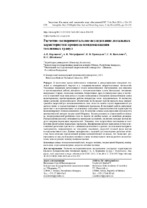| dc.contributor.author | Карманов, А. Е. | |
| dc.contributor.author | Митрофанов, А. В. | |
| dc.contributor.author | Приходько, Е. В. | |
| dc.contributor.author | Василевич, С. В. | |
| dc.contributor.author | Шпейнова, Н. С. | |
| dc.coverage.spatial | Минск | ru |
| dc.date.accessioned | 2023-12-12T07:38:46Z | |
| dc.date.available | 2023-12-12T07:38:46Z | |
| dc.date.issued | 2023 | |
| dc.identifier.citation | Садкин, И. С. Расчетно-экспериментальное исследование локальных характеристик процесса псевдоожижения топливных гранул = Computational and Experimental Study of Local Characteristics of the Fluidization Process of Fuel Pellets / А. Е. Карманов [и др.] // Известия высших учебных заведений и энергетических объединений СНГ. Энергетика. – 2023. – № 6. – С. 524-535. | ru |
| dc.identifier.uri | https://rep.bntu.by/handle/data/138369 | |
| dc.description.abstract | В настоящее время наблюдается тенденция к диверсификации генерации тепловой и электрической энергии и к совершенствованию твердотопливных технологий. Указанные тенденции актуализируют поиск математических инструментов для описания и прогнозирования работы аппаратов с псевдоожиженным слоем дисперсных топливных материалов. Однако, поскольку механика гетерогенных сред (и дисперсных сред, в частности) в известной мере находится в стадии становления в отношении математических основ моделирования, прогнозирование работы аппаратуры часто затруднительно. В частности, низкое качество математического обеспечения не позволяет прогнозировать поля концентраций и скоростей фаз псевдоожиженного слоя, хотя эти знания служат первоосновой для расчета тепло- и массообменных и химических процессов. В настоящей работе выполнено расчетное и экспериментальное исследование локальных гидромеханических характеристик монодисперсного псевдоожиженного слоя. В качестве основы моделирования используется математический аппарат теории цепей Маркова. Задачи решаются в одномерной постановке, подразумевающей разбиение слоя по высоте на ячейки малых, но конечных размеров. Распределения фаз слоя описываются векторами состояний, эволюцию которых контролируют матрицы переходных вероятностей. Элементы этих матриц были поставлены в соответствие физическим параметрам процессов. Верификация модели выполнена путем сопоставления расчетных прогнозов с данными проведенного в рамках исследования натурного эксперимента, направленного на измерение локальных скоростей газовой фазы внутри псевдоожиженного слоя. Данные эксперимента с хорошей для инженерных расчетов точностью были описаны предложенной физико-математической моделью, что позволяет рассматривать ее как достоверную научную основу компьютерного метода расчета котлоагрегатов, использующих технику псевдоожижения. | ru |
| dc.language.iso | ru | ru |
| dc.publisher | БНТУ | ru |
| dc.title | Расчетно-экспериментальное исследование локальных характеристик процесса псевдоожижения топливных гранул | ru |
| dc.title.alternative | Computational and Experimental Study of Local Characteristics of the Fluidization Process of Fuel Pellets | ru |
| dc.type | Article | ru |
| dc.identifier.doi | doi.org/10.21122/1029-7448-2023-66-6-524-535 | |
| local.description.annotation | Currently, there is a tendency to diversify the generation of heat and electricity and to improve solid fuel technologies. These trends actualize the search for mathematical tools for describing and predicting the operation of apparatuses with a fluidized bed of dispersed fuel materials. However, since the mechanics of heterogeneous media (and dispersed media in particular) is to a certain extent in its infancy in relation to the mathematical foundations of modeling, it is often difficult to predict the operation of equipment. In particular, the poor quality of mathematical basis does not allow predicting the fields of concentrations and velocities of the phases of the fluidized bed, although this knowledge serves as the fundamental basis for calculating heat and mass transfer and chemical processes. In the present work, a computational and experimental study of the local hydromechanical characteristics of a monodisperse fluidized bed has been carried out. The mathematical apparatus of the theory of Markov chains was used as a basis for modeling. The tasks were solved in a one-dimensional formulation, which implied the division of the bed in height into cells of small but finite sizes. Fluidized bed phase distributions were described by state vectors whose evolution was controlled by transition probability matrices. The elements of these matrices were matched to the physical parameters of the processes. The model was verified by comparing the calculated predictions with the data of a full-scale experiment conducted as part of the study, aimed at measuring the local velocities of the gas phase inside the fluidized bed. The experimental data with a good accuracy for engineering calculations were described by the proposed model, which makes it possible to consider it as a reliable scientific basis for the computer method for calculating installations using the fluidization technique. | ru |

